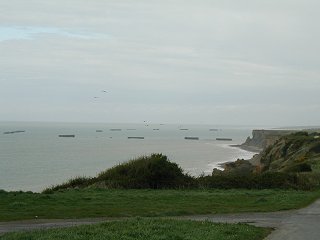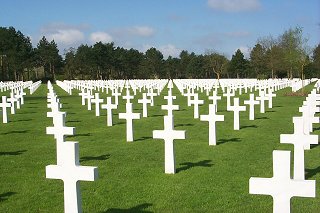On June 6, 1944 the largest offensive in world history began
on the beaches of Normandy: D-Day.
We visited several of the memorial sites to try and get a feel for what it
was like to fight in and live through the war years. The war memorial in
Caen and the American Cemetery at Omaha Beach make you stop and think. The
bunkers at Longes sur Mer and Pointe du Hoc were wonderful places for the kids
to run and explore. The signs for 'Golf at Omaha Beach-27 holes' make you
wonder about today and the kids making castles in the sands of Omaha beach makes
you thankful for the people who cared enough to give their all for the future.
Omaha Beach
D-Day was a coordinated attack on five beaches along the Normandy
coast: Utah, Omaha, Sword, Juno, and Gold. At Omaha beach,
everything seemed to go wrong. Where the other landings took up to 2 hours
to gain a secure beachhead, it took all day and several thousand wounded and
killed to get ashore here. This is the beach shown in movies such as 'The
Longest Day' and 'Saving Private Ryan'.
Today, this beach is a long and smooth stretch of sand used for sail car
classes (three wheeled skiffs with a sail) and the object of pilgrimages for
people trying to understand what the war was about.
When Alex and Juli started to play in the sand, running and laughing and
having fun, we quickly realized this is what the war was all about.
Longes sur Mer
The Germans defended the coast with batteries of guns that could fire up to
20 kilometers over the sea. These guns were arranged so that the beaches
and any supporting ships would be under direct fire. These guns were
heavily bombed prior to the invasion and few are remaining today. The
concrete bunkers and guns at Longes sur Mer have been left in place and are open
for exploration. The children (including Perri) loved being able to climb
and explore these modern 'castles'.
Pointe du Hoc
On the morning of the attack, 225 U.S. Army Rangers scaled the shear cliffs
of the Pointe du Hoc, hoping to catch the Germans unawares and to disable the
gun battery that would threaten the attack on Omaha beach. At the end of
the fighting, 90 Rangers were left unwounded and it was discovered that the
large guns had been removed months earlier after heavy bombardment had damaged
them.
The Pointe is now a memorial and has been left as it was after the
battle. The barbed wire is strung, the bunkers are crushed and twisted,
the bomb craters have not been filled in. Although much is now covered
with grass, it is powerful to imagine climbing over the cliff wall and being
confronted with the freshly turned soil from the bombs and the need to clear an
entrenched enemy from a maze of interlocking, reinforced concrete tunnels.
As powerful as that image was, our clearest memory was of the children
running in and out of the bomb craters as if they were on skate boards with hair
flying and the dog chasing, finding joy in the today.
Arromanches
For any prolonged attack to succeed, tons of military material and millions
of solders needed to be brought ashore. Not being naive, the Germans
heavily defended the natural ports and destroyed them as they pulled back,
putting the ports out of service for months. To overcome this obstacle,
the Allies created two man-made harbors of concrete walls and floating
bridges. The walls were in sections that were towed from England, filled
with sand, and sunk to form break walls. The bridges were shipped over and
extended across the long beaches to temporary floating docks where the Liberty
ships were unloaded.
The artificial harbor at Omaha Beach was destroyed in a strong
storm two weeks after the battle that secured the beach and was abandoned.
The second harbor was at Arromanches where, today, we were able to see the
remains of the break walls as well as pieces of a floating bridge. At low
tide we could walk out to some of the pieces and get a feel for the scale of the
effort. There was also a wonderful museum just off the beach with models,
photographs, movies, and displays that bring this logistical miracle to
life. 2.5 million soldiers and the hardware they needed to fight the war
were brought into France through the ports of Normandy.

American Cemetery at Omaha Beach
All of this did not come for free. As anyone who has watched the war
movies has 'seen', the D-Day invasion came at the price of thousands of dead and
wounded soldiers and nurses. Many of the American dead are buried in the
American Cemetery at Omaha Beach. It is a quiet, solemn testimony to war
with the row after row of white marble crosses and stars-of-David.
D-Day was the beginning of the end to a terrible time in the history of the
world. As an Americans living in France, we are deeply thankful for the
sacrifices that were made to allow us to be here.

Return to top